Introduction to the Medio Real Series
by Dave Busse
The medio real (½R) has long been a popular coin and researched by several different scholars in the field of Mexican numismatics. The outstanding works by Clyde Hubbard and David O’Harrow, Hookneck El Aguila de Perfil and the supplement Hookneck II are essential to any serious collector of that series and important to the ½R collector even though there is only one known issue of the Hookneck ½R, the Mo 1824 JM.
A total of either eleven or twelve different mints produced the ½R between 1824 and 1870. However, one of the intriguing aspects of the Republic ½R series is that despite the fact that small coins were essential Ito everyday commerce in 19th century Mexico only about half of those mints struck them in large numbers and/or with regularity. For those of you not familiar with the ½R even a cursory study of any catalog listing the ½R will show that Alamos and Estado de México produced the coin in only one year and the Chihuahua mint produced them in only two years. The single reported ½R from Alamos is dated 1862 and some controversy surrounds its authenticity (see further details below). Estado de México struck the coin only in 1829 even though it produced 8R in 1828, 1829 and 1830. Chihuahua struck the ½R only in 1844 and 1845 despite producing 8R from 1831 through 1895. This has been partially explained by some researchers who have reasoned that the Chihuahua 8R was struck, in the main, for export; and therefore the minors were not a priority. Another mint, Hermosillo, has only three reported dates – 1839 (not officially open then and there is some question as to its authenticity), 1862 and 1867. As far as we know; neither Catorce nor Oaxaca struck the ½R.
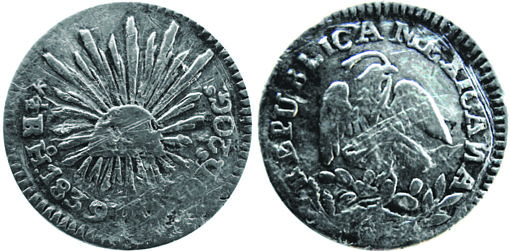
The above is the only ½R HO 1839 PP I have seen. Note the broken star and the retrograde N in MEXICANA. The owner was kind enough to send a scan, but I have not been able actually to examine the piece and therefore make no claims as to whether or not it is genuine.
The standard Republic ½R is 16 mm in diameter and has a Fineness of 90.027% silver with a base metal of copper. The edge design is referred to as ornamental. Fineness is expressed as “10 DS 20 GS” (with the DS and GS being abbreviations for Dineros and Granos) and found as part of the legend on the Cap side of the coin. Twelve Dineros is pure silver and each Dinero can be divided into 24 Granos. Thus 10 DS 20 GS is 10 of a possible 12 Dineros plus 20/24 of another Dinero (when added together it comes to nearly 11/12) and calculates (260 ÷ 288) to be 90.27% silver when converted to the decimal system. The obverse features the ancient Aztec symbol of victory; an eagle grasping a water snake in its beak and its left claw (from the observer’s point of view) while using the other leg to stand on a cactus that is rising out of Lake Texcoco. Below and to the right are laurel branches, leaves and berries, to the left are oak branches with leaves and acorns. The legend around the top half of the outer perimeter reads REPUBLICA MEXICANA. Sometimes there is a dot after MEXICANA and sometimes there is not. The reverse features a Phrygian Cap with the word LIBERTAD (Liberty) in block letters across its base. Extending out from behind the Cap are Rays. Thus, the design signifies the dawning of liberty (freedom from Spanish rule) in Mexico. The reverse legend reads “★ ½R • MM • date • assayer initials • fineness • ” for example a Guanajuato ½R minted in 1828 would read: ★½R • GO • 1828 • J • M • 10 DS • 20 GS •. Note that this is the same format used by all denominations in the Cap and Rays series – this one as well as the 1R, 2R, 4R, and 8R. You should also be aware that there were several variances from mint to mint and even year to year within an individual mint such as no star, a six, seven or even eight pointed star instead of the normal five pointed one, irregular spacing in the legends, missing or improperly placed dots, reversed superscript “S” and even missing superscript “S“. In addition, there were over-dates, over-assayers, and re-punched stars, dots, mintmarks, dates, assayer initials, fineness numbers and letters which many collectors of the series find fascinating. Depending on how much detail one chooses to include in his/her collecting criteria, varieties can be almost endless as every separate set of dies, especially prior to 1854, was at least slightly different from those preceding and following. An interesting one is the number of berries and acorns in the wreath below the eagle. I have seen as many as six and as few as two. Some collectors use the term “Incomplete Wreath” to describe such a variety.
Mexico City is the only mint that struck a Hookneck ½R and all known examples bear the date 1824. It has always been a popular coin because of the Profile Eagle design and the fact that the style was used in only one year. The Facing Eagle style ½R specifications – diameter, weight, and fineness – remained the same as those of the Hookneck. Struck at either eleven or twelve different mints between 1825 and 1869 the ½R is one of the most popular coins for collectors specializing in the Republic of Mexico. As with the other denominations the ½R can usually be found in circulated condition rather easily and often for a pittance. However, you probably also know that there are some extremely rare mint date assayer combinations and aside from the more common (Mexico City, Culiacán, Guadalajara, Guanajuato, and Zacatecas mints, all have at least a few years where large numbers were produced) and/or hoard coins, Uncirculated specimens are difficult to locate. I am convinced that the reason for this is that the ½R was essential to everyday commerce among the populace and therefore entered circulation quickly. The list below shows the mints and the years they struck the ½R.
| Mint | Years Struck |
| Alamos | 1862 (note controversy surrounds the one reported specimen, some authorities say it is genuine while others say it is not) |
| Chihuahua | 1844-45 |
| Culiacán | 1846, 1848-49, 1852-54, 1856-58, 1860-63, 1867, 1869 |
| Durango | 1832-34, 1837, 1841-43, 1845-46, 1848-62, 1864, 1869 |
| Estado de México (Tlalpan) | 1829 |
| Guadalajara | 1825-26, 1828-32, 1834-35, 1837-62 |
| Guadalupe y Calvo | 1844-51 |
| Guanajuato | 1826-62, 1867-68, 1870 |
| Hermosillo | 1839, 1862, 1867 |
| Mexico City | 1824 (Hookneck)-36, 1838-63 |
| San Luis Potosí | 1831, 1841-63 |
| Zacatecas | 1826-63, 1869 |
The reason for not being specific as to the number of mints is that more than one notable numismatist believes the Alamos – ½R A 1862 P.G. – was never actually minted and that the one known example is not genuine. Note that Superior Stamp & Coin Company, in the Miguel Muñoz Sale II in June 1979, claimed that the 2R was the only minor minted at Alamos. Regardless of one’s position as to the authenticity of the coin, it is most unlikely that a collector will ever have the chance to own it, as it is thought to be a unique specimen. Thus, if you consider it genuine, you have to go into the medio real series knowing that in all likelihood you will not ever complete either a Type (by mint) or an MDA (Mint-Date-Assayer) set.
At this time, as far as we know, neither Catorce nor Oaxaca struck the ½R.
Die Styles
The die styles within the basic Type are fascinating to those of us bitten by the Mexican coin bug. One of the first issues to be addressed is that most catalogs and references refer to the Hookneck as a specific Type. I would argue that it is a Style rather than a Type. Obviously, whether one chooses to designate it a Type or a Style has no effect on the popularity or value of the Hookneck die style. The argument for calling it a die style is that it has the same basic design elements as any of the Facing Eagle style. For example it has the eagle grasping a snake in one talon and its beak while perched on a cactus that is rising out of Lake Texcoco. The lower half of the perimeter has oak branches, leaves and acorns to the left and laurel branches, leaves and berries to the right. The upper half of the perimeter has the legend REPUBLICA MEXICANA. On the Cap side it has the Liberty Cap with the word LIBERTAD across it with rays extending out from behind it. The Cap side legend reads – ★ ½R • MO 1824 • J • M • – so other than the fact that the eagle is facing on one and profile on the other and that there are some differences in the Cap I believe both the Hookneck and the Facing Eagle should be considered different styles of the same Type.
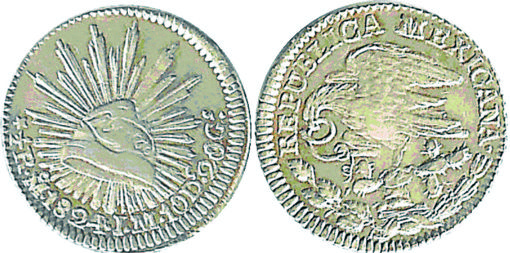 Hookneck Eagle style
Hookneck Eagle style
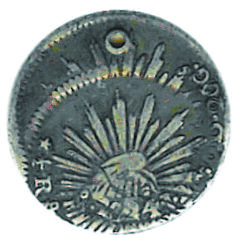
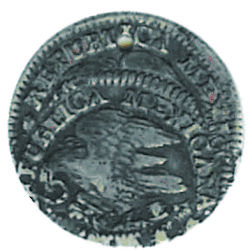
Double struck example
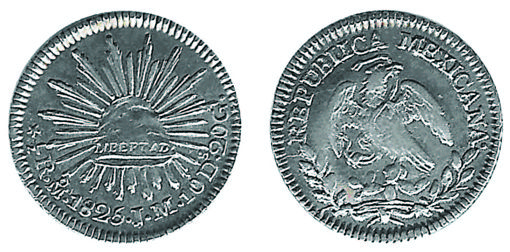 Facing eagle style
Facing eagle style
Any of the mints that have fairly long production runs show a number of different die styles over time, and occasionally in the same year. Below are two examples:
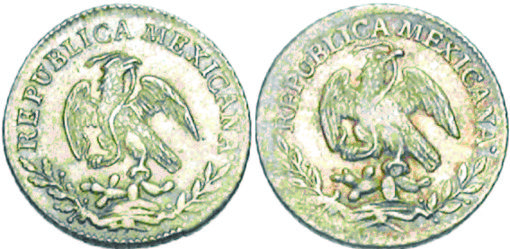 Eagle of 1827 Eagle of 1828/7
Eagle of 1827 Eagle of 1828/7
The first is a Mexico City 1827, while the second is Mexico City 1828/7. A simple examination reveals obvious differences including but not limited to:
• 1828 eagle is bigger and more robust
• Upper beak on 1827 has more of a hook to it
• No lower beak on the 1828
• Right wing is smaller and sharper on the 1827
• Snake’s upper body is noticeably closer to the top of the eagle’s head on the 1827
• Oak leaves on the 1828 are less defined (almost rounded like the laurel leaves)
• There are subtle but noticeable differences in the letters of the legend as well as how they were punched.
Obviously, most serious collectors can find additional differences, but my point is that one can see the difficulty that the die sinker had engraving/punching the dies by hand. Obviously, whenever a mint had to change dies because of wear, damage or some other reason, a new set of dies that had to be prepared by hand would be at least slightly different.
Interestingly, we can see that with rarer examples the die style does not always change. Compare the two Chihuahua ½R pieces below. I have studied both extensively “in the flesh” and as far as I can determine, the Eagle side and the Cap side dies are the same for both coins except the date was changed for the 1845 though I found no trace of an overdate. Due to the toning, some details were not picked up on the reproductions of the coins. By the way, those are the only two High Grade Chihuahua ½Rs of which I am aware.
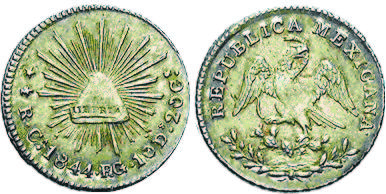
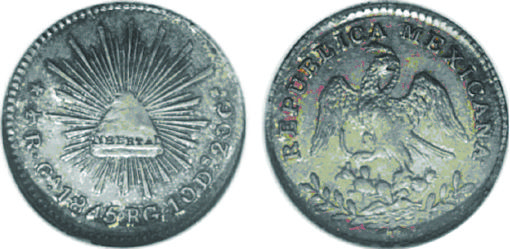
Note that several of the rays on the 1845 are not quite as sharp as those on the 1844, whether that wasdue to wear on the dies, the strength of the strike or a combination of both has not yet been determined. The same applies to the wings on the Eagle side.
Varieties
Variety collectors can enjoy the ½R series as long as they choose to continue collecting. Three mints – Mexico City, Guanajuato and Zacatecas – produced many, many varieties and a high percentage of them were undoubtedly unintentional. That is not to say that some of the other mints did not also produce varieties, it is just that those three seem to have an abundance of them. That can probably be explained by the fact that Mexico City, Guanajuato and Zacatecas struck the largest numbers of the ½R. There are some well known and popular varieties including several over dates, over assayers, and errors. One of the first of what I consider to be a major error variety occurred at Guanajuato in 1828. That year there is an over date, 1828/7, plain date 1828, assayer initials MJ and MR. However, what is really interesting is that there is a combination denomination error 2/1 instead of ½ and mintmark error “G” only instead of a small “o” inside the opening of the G. Later we find a regular denomination but the “G” only remains even with the MR assayer. I have studied both the inverted denomination and the assayer MR with the “G” only and found traces of something inside the opening of the G, but cannot state definitively that it is the elusive missing “o” in either one. Unfortunately, I have never seen a High Grade (Extra Fine or better) example of either variety, so my conclusions remain somewhat speculative.
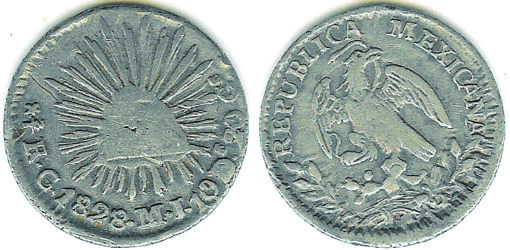 ★ 2/1R • G•1828•M•J•
★ 2/1R • G•1828•M•J•
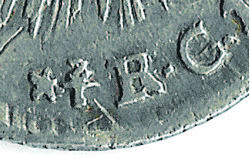 Close up of inverted denomination and G only mintmark
Close up of inverted denomination and G only mintmark
Another interesting variety from the Mexico City mint (it has been overlooked/unreported by standard references including the Clyde Hubbard and Theodore Buttrey, A Guidebook of Mexican Coins 1822 To Date, as well as the latest 2008 North American Coins & Prices A Guide to U. S., Canadian and Mexican Coins, 17th Edition from Krause Publications) is the MO 1841 ML which has two stars (★ ★) in the Cap side legend. By the way I am aware of one such coin in Mint state.
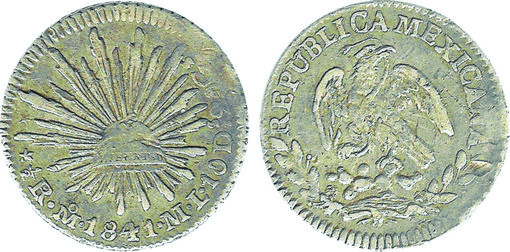
★ ★ ½R • Mo •1841• M • L• Two Stars variety
Yet another unmentioned one from Zacatecas is the ½R Z 1833 OM. First on the Cap side legend we have a six-pointed star - ★ - next we have a 2/1 that has been corrected to a ½, and lastly we have a large assayer initial M when compared to the assayer initial O and the rest of the legend. Keep in mind that the ½R mintmark for Zacatecas is a Z only through 1856. Also, the one pictured below is a Choice Mint state example so it will give the reader some idea of just how crude many of the early issues were.
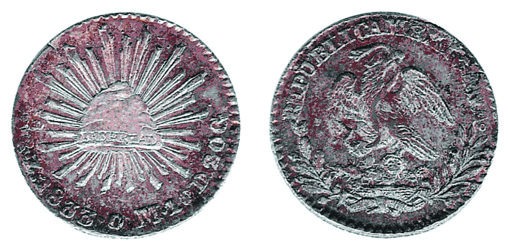 ★ ½R • Z .1833 • O • M • (Note large M assayer initial)
★ ½R • Z .1833 • O • M • (Note large M assayer initial)
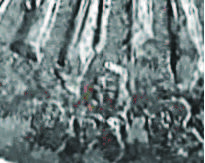
Close up of ½ over 2/1. The loop of 2 is plainly visible as it was not fully removed after the error had been noticed and “corrected.”
The author also thinks there is one from Hermosillo that is worthy of discussing, namely what is usually referred to as the overdate 67, 6/ inverted 6 and 7/1. While I agree that the 6 is over an inverted 6, the properly oriented 6 is more weakly defined than the inverted 6 to the point that some even think it is an inverted 6 over a normal 6. While that is interesting, what is even more so is the claim of 7/1. Even a cursory study shows that it is much more likely that the 7 is over a 2 rather than a 1. Compare the numeral that the 7 is punched over to the 1 that starts the date. The first 1 does not have a base on the “1” while the numeral under the 7 – if it is a 1 – has a wide base causing one logically to conclude that a different punch was used to make it. Thus, one can deduce that the 7 is over a 2 rather than a 1 without a base. A further argument that it is a 7/2 is that Hermosillo did not strike a ½R in 1861 while it did produce one is 1862 but none between 1862 and 1867. All examples of the 1862 that I know of are a plain date 1862. Interestingly, there is no argument that the assayer initials P and R are over the assayer initials FM and the 1862 issue has the assayer initials FM. Therefore, I would argue that the correct attribution should be 1867, 6/ inverted 6, 7/2 and PR/FM.
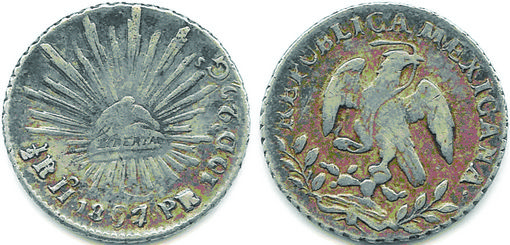 ½R Ho 1867 PR 10 DS 20 GS “6 over inverted 6, 7/2, PR/FM”
½R Ho 1867 PR 10 DS 20 GS “6 over inverted 6, 7/2, PR/FM”
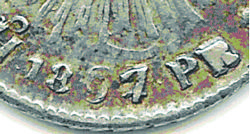 Cap side enlarged to show detail better
Cap side enlarged to show detail better
Note incomplete legend, no star and close study shows no dots (those appearing to flank the date are not actually dots but dings caused by circulation). The legend is crude; the superscript O of the mintmark is not complete nor is it centred above the uprights of the H. The attempt at removing the inverted 6 was so poorly done that it appears to be over the properly oriented 6 which is high compared to the rest of the date; the numeral under the 7 more closely resembles a 2 than a 1: in fact there seems to be a slight roundness at the top of the 7 as well as a ball shaped piece under the left side of the horizontal part of the 7 resembling that on the 2 of 20 GS; thus the assertions that it is actually a 7/2. The PR/FM is weak but discernible. The indentation appearance between the 7 and the rays coming form the bottom of the cap is from clashed dies.
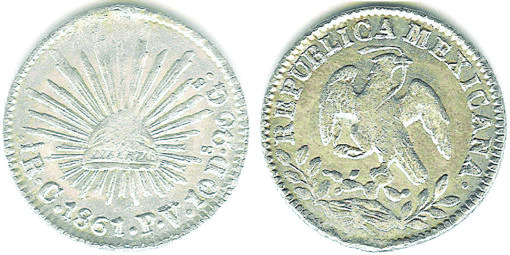 ★ 1/1R • C.1861.P.V.
★ 1/1R • C.1861.P.V.
Here is a popular error variety struck at Culiacán (appears in more than one year). Note the denomination of 1/1R instead of a ½R (most catalogs say is it an 1 instead of a ½ but clearly it is a 1/1). Note also the very low Micro Star.
Alamos
For a consideration of the rarity of Alamos ½ real see here.
Chihuahua
For a consideration of the rarity of Chihuahua ½ reales see here.
Culiacán
For a consideration of the rarity of Culiacán ½ reales see here.
Durango
For a consideration of the rarity of Durango ½ reales see here.
Estado de México
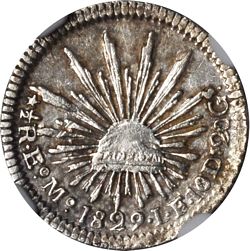
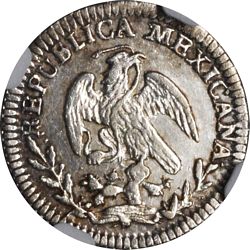
KM-370.4 Estado de México ½ Real, 1829-EoMo LF (Stack’s Bowers auction, 13 February 2019, lot 71390)
For a consideration of the rarity of Estado de Mêxico ½ reales see here.
Guadalajara
For a consideration of the rarity of Guadalajara ½ reales see here.
Guadalupe y Calvo
For a consideration of the rarity of Guadalupe y Calvo ½ reales see here.
Guanajuato
For a consideration of the rarity of Guanajuato ½ reales see here.
Hermosillo
For a consideration of the rarity of Hermosillo ½ reales see here.
Mexico City
For a consideration of the rarity of Mexico City ½ reales see here.
San Luis Potosí
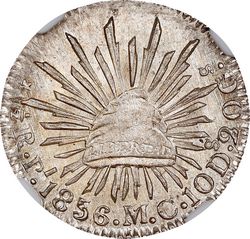
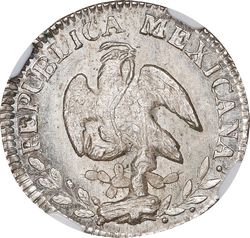
KM-370.10 ½ Real San Luis Potosí 1856 (Stack’s Bowers Auction, 21 October 2023, lot 71004)
For a consideration of the rarity of San Luis Potosí ½ reales see here.
Zacatecas
For a consideration of the rarity of Zacatecas ½ reales see here.
